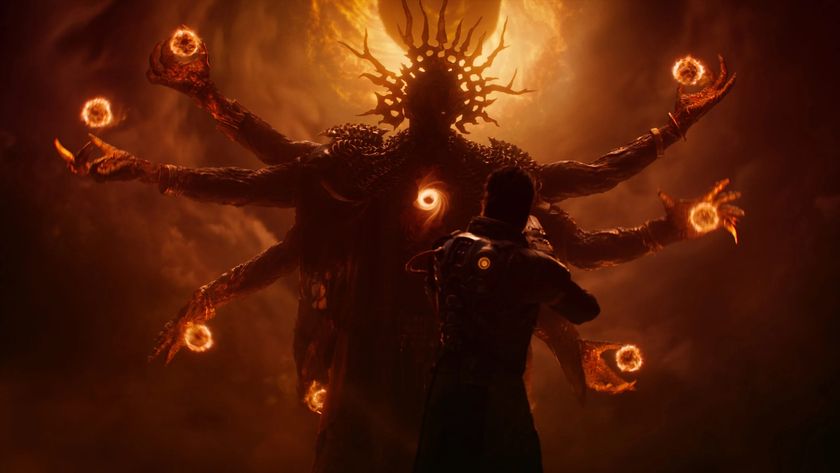The 2008 PC Builder's Bible
Find the best parts. Learn to build a rig from scratch and overclock it to kingdom come. PC Gamer shows you how
Q: Let’s start with the basics. What is a CRT?
A: Cathode Ray Tube. CRT monitors are just fancy implementations of the same technology used in TVs: An electron beam originating from the base of
a vacuum-sealed tube scans across the tube’s screen, which is covered with a layer of phosphor material. A metal grating or wire mesh limits how much of the electron beam can hit individual phosphor clusters, thus leading to an acceptably sharp image. When the phosphor material becomes excited, it glows either red, green or blue. Mix up several differently colored phosphor clusters and suddenly you have millions of colors. Although it is possible to make flat or nearly flat cathode ray tubes, most older models exhibit some curvature, at least around the corners.
Q: But I have no desk space! What is an LCD?
A: Liquid-Crystal Displays are modern alternatives to CRTs. LCD manufacturing starts with a flat pane of glass, which is then layered with a grid of small transistors; the transistors are arranged in groups of three, and each triad describes a screen pixel. When excited by electricity, these transistors can be made to open and shut. Put a backlight behind the transistor grid and, behold, you have an image. There’s more to it than that, but that’s the basic idea.
Q: What type of display is the best for gaming?
A: The knee-jerk recommendation has long been “a primo 19-inch CRT.” Why? Because CRTs were better suited for gaming than LCDs, and because 19-inchers have always been great values, price-wise. However, in today’s modern age of affordable LCDs with blazing-fast refresh rates that eliminate the ghosting and bluring effects that plagued earlier generations of monitors, we at PC Gamer are all on 20” widescreen LCDs, and we’re loving them. Not only do they save desk space (and your back, if you ever want to move them), but the image is as sharp and clear as you could want. The one drawback is that they don’t look as good if they’re not at their native resolution, but that’s a small price to pay.
Q: What is an optimal refresh rate?
A: On an LCD, this is a no-brainer—use whatever refresh rate the manufacturer tells you to use for the native resolution of the panel (this is the resolution the display has to run at in order for everything to look normal, i.e., not stretched out, squished, or jaggy). This is almost always 60Hz, even if the monitor may be able to handle higher. Don’t worry - LCD pixels don’t fade and strobe the way CRT pixels do, so 60Hz won’t cause eyestrain. CRTs are a little trickier. While some would answer “as high as a resolution as the CRT will allow,” we recommend taking a more cautious approach. First, make sure you’ve loaded the Windows drivers for your particular display before you mess with the refresh rate settings. With the driver loaded, Windows won’t let you choose a rate higher than the monitor can display without damage to its circuitry. Our advice is to stay away from 60Hz, but 75Hz or higher will be just dandy.
Sign up to the 12DOVE Newsletter
Weekly digests, tales from the communities you love, and more

Screen size
This figure is the size of the LCD panel measured diagonally from corner to corner. Desktop screens range in size from 15 to 24 inches and beyond. We consider 19 inches the minimum for all-purpose computing. You need at least that much screen real estate to work in multiple windows comfortably, and to thoroughly enjoy high-definition video and PC games.
Aspect ratio
A display’s aspect ratio is its screen width divided by its height. The majority of desktop monitors have an aspect ratio of 4:3, regardless of their screen size; and the majority of software applications and computer games are designed accordingly. This is something to bear in mind if you’re considering a widescreen model, which typically has an aspect ratio of 16:10. If content, such as a game, insists on a 4:3 ratio, the display will stretch the content to fill the entire screen, making everything look fatter than it should. This situation is becoming less of a problem, as most games support at least one widescreen mode that won’t look distorted.
Native Resolution
Every LCD sports a fixed number of pixels arrayed in a grid that is a certain number of pixels high and a certain number of pixels wide. The native resolution is the width of the display (in pixels) by the height (in pixels). The native resolution will deliver an optimum picture. While it’s possible to run an LCD at a lower, non-native resolution, the image will be rescaled and the display will use interpolation to fill in the missing pixels, which can degrade image quality. Native res and interpolation quality are of particular concern to gamers, who often run games at low resolutions to get the best frame rate. An LCD’s native resolution is typically determined by its screen size. For example, many 19-inch monitors have a native resolution of 1280x1024, while many 20-inch models have a native resolution of 1600x1200. A higher resolution makes everything look smaller onscreen, but also gives you more desktop space.
Interface
Today’s LCDs connect to the graphics board via either an analog VGA connector or a digital DVI connector. If your graphics board is equipped with DVI outputs—most modern boards are - we recommend you use DVI to connect to your LCD. Unlike CRTs, which must refresh every pixel on the screen 60-plus times a second, LCDs modify pixels only when they change. The analog connection is less precise because the digital information must be converted to an analog stream in order to travel to the LCD, where it is then analyzed and converted back to a digital format. This is a recipe for data loss or corruption in the image that is ultimately displayed on-screen.
Pixel response time
This spec has been getting a lot of play lately, so it deserves mention. A pixel’s response time, measured in milliseconds, describes the time it takes for a pixel to change from its on state to its off state and then back on again. If the response time is too slow, you’ll see ghosting and other artifacts because the display’s pixels can’t keep pace with the information sent from the graphics card. This problem is particularly noticeable in games, which tend to have fast action sequences. A response time of 25 milliseconds was once the norm, but it’s not uncommon these days to see response times listed in the single digits. As impressive as this spec sounds, it should be taken with a grain of salt. Different manufacturers report response times differently, so this spec isn’t a reliable means of comparing different brands. Some vendors report only the pixels’ rising (turning on) or falling (turning off) time; others report how long it takes for a pixel to turn on, turn off, and then turn on again; and still others report the time it takes for a pixel to go from peak white to full black. (Pixels change from white to black much faster than they change from gray to gray, but the latter is a more common occurrence in real-world use.) Because of this inconsistency, we don’t normally report on a display’s pixel response time, but we mention it here to illustrate a point: Response-time specs often do not jibe with qualitatively measured performance. The best way to determine an LCD’s abilities with fastpaced content, in our opinion, is to eyeball it first-hand.
Ergonomics
Obviously, the more ability you have to adjust your screen’s height, tilt, and orientation to fit your body, the better.

Three recommended monitors
Head back to the table of contents
PC Gamer is the global authority on PC games and has been covering PC gaming for more than 20 years. The site continue that legacy today with worldwide print editions and around-the-clock news, features, esports coverage, hardware testing, and game reviews on pcgamer.com, as well as the annual PC Gaming Show at E3.
Most Popular







